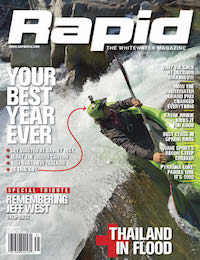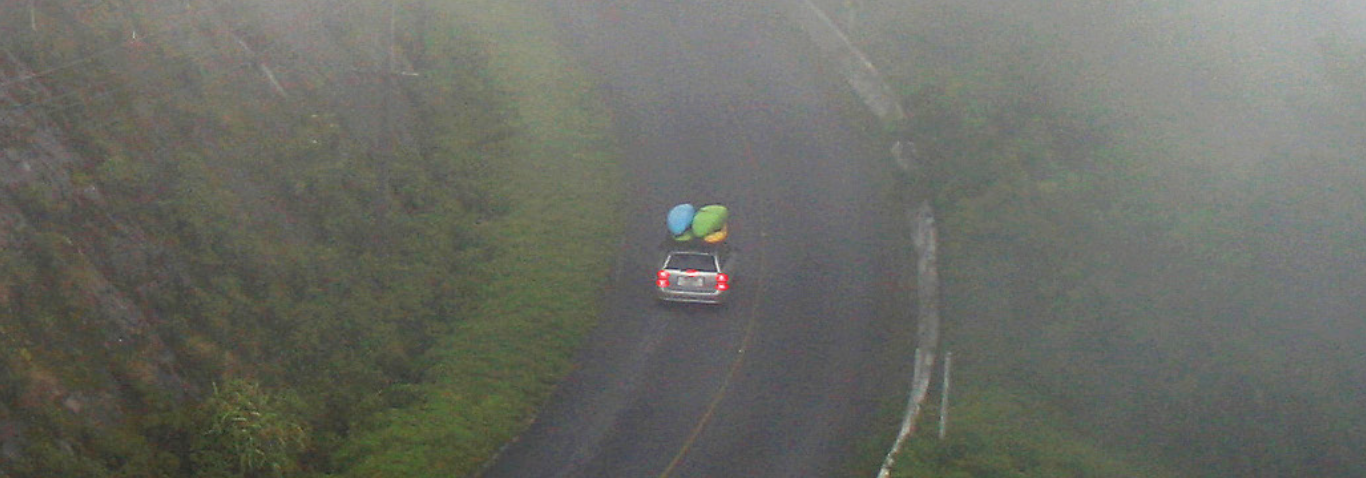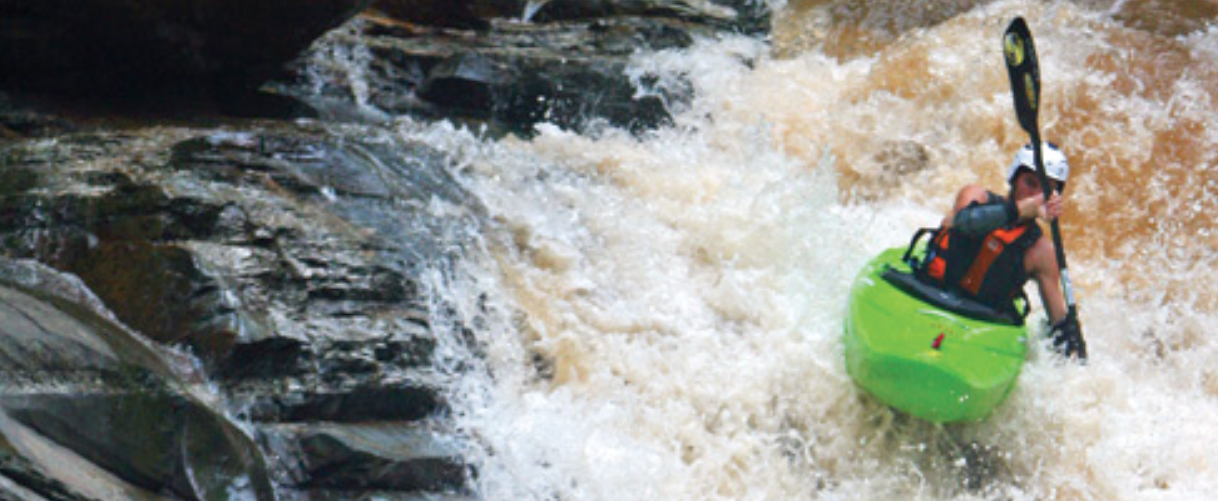Known for its hot, sunny beaches, Thailand is an idyllic travel destination for most of the year. During the three-month monsoon from July to September however, tourists run for cover. As copious amounts of rain falls, streams, creeks and rivers swell creating the ideal conditions for a kayaking trip.
Most tourists go to Thailand for its rich history of Buddhism, agriculture and dynasty. As a kayaking destination, it’s still in its infancy and the abundance of steady, virgin whitewater makes it appealing. The underdeveloped paddling scene offers an element of exploration— as long as you are willing to put in some effort to seek out the runs, you will be rewarded.
STARTING THE ADVENTURE
Our adventure started the moment we stepped off the plane in Bangkok. We made it our mission to get out of Bangkok as quickly as possible with plans to return later in our trip once we grew more accustomed to traveling in Thailand. For the moment, we focused on making our way north to Chiang Mai, home to the country’s best whitewater. There’s a direct train that takes passengers across the 750-kilometer stretch of jungle and countryside to Chiang Mai but our group of four hired a rental car. We craved the freedom to explore the rivers and falls along the road north.
Finding a quality rental car in Bangkok was easy; the hard part was getting it out of the city. Traffic signs are written in Thai and we shared the road intimately with thousands of bicycles, mopeds and tuk-tuks—moped taxis. I felt confident navigating my way through Bangkok’s narrow, congested side streets, my passengers with their heads out the windows making sure I didn’t run anyone over. Then I merged onto the highway. The congestion didn’t disperse. Instead, still more cars and mopeds packed even closer together and moved at a much quicker pace. The blood finally returned to my fingertips when I loosened my white-knuckle grip 20 kilometers outside the city.
UNDERSTANDING NAMTOK
As we made our way north, our time and budget allowed us to chase the great white namtok—the Thai term for waterfall. With the motivation to get off the beaten path and a penchant for mischief, it wasn’t hard to get sidetracked for a couple of days.
We quickly developed a love-hate relationship with the signs the Thai people have erected to celebrate their beloved falls. A road sign marks almost every drop in the country. After passing a handful, we finally decided to turn off the highway in search of a runnable waterfall.
We followed the signs to an obscure trailhead and down a path. The beauty of the trail was overshadowed by the soupy midday humidity. Still we excitedly ran the final 100 meters to the water’s edge. Only a few of the dozens of signs we followed gave any more information than the waterfall’s name, so it took us a moment to realize that the shallow brook trickling onto a pile of rocks in front of us was the main attraction.
With no well-established source for river beta and our elementary command of the Thai language, we were skunked more then once. However, failures like this were always quickly forgotten. Every beautiful drop, big and small, is hidden away in a jungle paradise.
EXPLORING CHIANG MAI
Chiang Mai is a great base for paddlers looking to spend an extended period in the area as it’s central to a good deal of the known boating in northern Thailand. The city itself was built in 1292, complete with surrounding moat and defensive wall to keep out the encroaching Mongol empire. Nowadays, it acts as the northern hub for commerce, tourism, and religion. We settled into our cheap rooms. At 200 Baht per night—just six bucks—the place was no Hilton, but offered a satisfactory place to sleep and beat overnighting in the car.
On good information from a friend, we made our way to the Siam River Adventures Center in downtown Chiang Mai. We were met by the lovely and hospitable owner Lah, who quickly set us up with a shuttle to the top of the river. The last leg of our route was by elephant, kayaks and all.
Travelers visiting Thailand on a shorter trip wanting to pack in as much paddling as possible will find everything they need in Chiang Mai. Like most kayaking destinations in and around the equator, flow is very dependant on rainfall. Luckily, it comes down in bucket- loads this time of year. Even during dry spells, though, there is still one really good option close by. The commercially rafted Mae Tang River—technical and boulder-strewn in low water and raging big-volume in high water— is just north of the city.
Chiang Mai also has plenty to do during time off the water. We took time to explore some of the city’s 300 Buddhist temples, indulging in the amazing cuisine and immersing ourselves in the vibrant Thai culture.
UNPADDLED WHITEWATER AND LOCAL AUTHORITIES
We spent much of our time hunting unpaddled whitewater, but when the big rains came, it was impossible to resist the known quality runs within a couple hours’ drive of Chiang Mai. Our first stop was the Mae Pan waterfall located in Doi Intatnon National Park.
After hurrying our boats and gear down the short trail to the falls, we quickly roped our kayaks to the top of the drop. I found myself sitting above a gorgeous horizon line, blasted by the mist from the thunderous 100-meter falls in the backdrop. We ran the 15-meter Mae Pan Falls and regrouped for high fives and hugs in the pool below before paddling the section’s remaining rapids. Energized from the morning’s session we quickly headed to the neighboring, equally spectacular Mae Klang River to round off an awesome day of paddling.
The region is teeming with other amazing pool and drop sets that would certainly be classics if anybody really paddled there. We hit the Mae Sa, a river that feels like a waterslide amusement park. Its put-in is at the Queen Sirikit Botanical Gardens, with boofs and slides past greenhouses, around bam- boo huts and through dangling jungle vegetation. Elephants trudge along the banks as the river passes through the Mae Sa Elephant Camp, eventually winding its way into the national park ending at the Mae Sa waterfall.
The Mae Sa run ends in a picture-perfect, six-meter drop. Park rangers stopped us moments before we could huck the drop, afraid we would be washed over the falls to our death. After some failed negotiating, they politely escorted us out of the park and back to our car, cutting the day short by one rapid.
Unable to explain our intent and that we are a group of experienced, capable and safe boaters, we decided on an it’s-easier-to-beg-forgiveness-than-ask-for-permission tactic. On some occasions we were able to persuade the rangers to let us back on the water, but a smile and double thumbs up only got us so far. Many of the park rangers carry machine guns, which made the whole begging for forgiveness thing a little dicey.
THE PERFECT WHITEWATER DESTINATION
Thailand offers lots of options for those with a bit more time on their hands looking to diversify their trip. Paddlers often jump the border into Laos to try one of that country’s many multi-day runs through undisturbed rainforest. Away from the whitewater, travelers flock south to the renowned warm, sandy beaches of Phuket Island where they kick back and relax, enjoy some world-class snorkeling, scuba diving and bumming around the beach. Those not into relaxing can join the 30,000 revelers who gather at Koh Phangan for the epic full moon parties that happen every 28 days.
Whatever your schedule, save at least a day or two before heading back to the airport to enjoy the circus that is Bangkok. It is an experience in and of itself. We hung out on the Khao San Road strip, the epicenter of tourist activity. With plenty of good restaurants and bars, and more cheap street vendors than you can shake a stick at, we explored a different kind of jungle. The nightlife wasn’t too bad either.
Thailand is much more than your standard kayaking destination. Rivers unfrequented by paddlers, more than enough spectacular attainable waterfalls and warm hospitality make it a perfect whitewater destination. Our trip was as much about the culture, cuisine and countryside as it was kayaking and we weren’t disappointed. When monsoon is listed as the reason, I now know to ignore the “When not to go” section of my guidebook.





